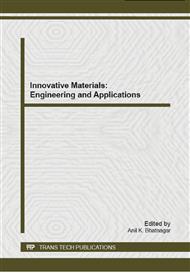[1]
P.D. Beer and P.A. Gale: Angew. Chem., Int. Ed. Vol. 40 (2001), p.486.
Google Scholar
[2]
M. Dong, Y. Peng, Y.M. Dong, N. Tang and Y.W. Wang: Organic Letters, Vol. 14 (2012), p.130.
Google Scholar
[3]
R. Koenig: Science, Vol. 287 (2000), p.1737.
Google Scholar
[4]
S. Xu, M. He, H. Yu, X. Cai, X. Tan, B. Lu and B. Shu: Anal. Biochem. Vol. 299 (2001), p.188.
Google Scholar
[5]
J. Ara, S. Przedborski, A.B. Naini, V. Jackson-Lewis, R.R. Trifiletti, J. Horwitz and H. Ischiropoulos: Proc. Natl. Acad. Sci. Vol. 95 (1998), p.7659.
DOI: 10.1073/pnas.95.13.7659
Google Scholar
[6]
G.L. Squadrito and W. A. Pryor: Free Radical Biol. Med., Vol. 25 (1998), p.392.
Google Scholar
[7]
R.T. Dean, S. Fu, R. Stocker and M.J. Davies: Biochem J. Vol. 324 (1997), p.1.
Google Scholar
[8]
X. Chen, T. Pradhan, F. Wang, J.S. Kim and J. Yoon: Chem. Rev. Vol. 112 (2012), p. (1910).
Google Scholar
[9]
H.N. Kim, Z. Guo, W. Zhu, J. Yoon and H. Tian: Chem. Soc. Rev. Vol. 40 (2011), p.79.
Google Scholar
[10]
Y. Yang, Q. Zhao, W. Feng and F. Li: Chem. Rev. Vol. 113 (2013), p.192.
Google Scholar
[11]
X. Wang, C. Zhang, L. Feng, et al.: Sensors and Actuators B: Chemical, Vol. 156 (2011), p.463.
Google Scholar
[12]
B. Shirinfar, N. Ahmed, Y.S. Park, G.S. Cho, S. Youn, J.K. Han, G.N. Hong, and S.K. Kwang: J. Am. Chem. Soc. Vol. 135(2013), p.90.
Google Scholar
[13]
X.H. Li, X.H. Gao, W. Shi and H.M. Ma: Chem. Rev. Vol. 114 (2014), p.590.
Google Scholar
[14]
H. Wang, L. Xue and H. Jiang: Organic letters, Vol. 13 ( 2011), p.3844.
Google Scholar
[15]
X.Y. Liu, D.R. Bai and S. Wang: Angew. Chem. Int . Ed. Vol, 45(2006), p.5475.
Google Scholar
[16]
Q.J. Zhang, Z.C. Zhu, Y.L. Zheng, J.G. Cheng, N. Zhang, Y.T. Long, J. Zheng, X.H. Qian and Y.J. Yang: J. Am. Chem. Soc., Vol. 134(2012), p.18479.
Google Scholar
[17]
C. Yu, M. Luo, F. Zeng and S. Wu: Anal. Methods, Vol. 4 (2012), p.2638.
Google Scholar


